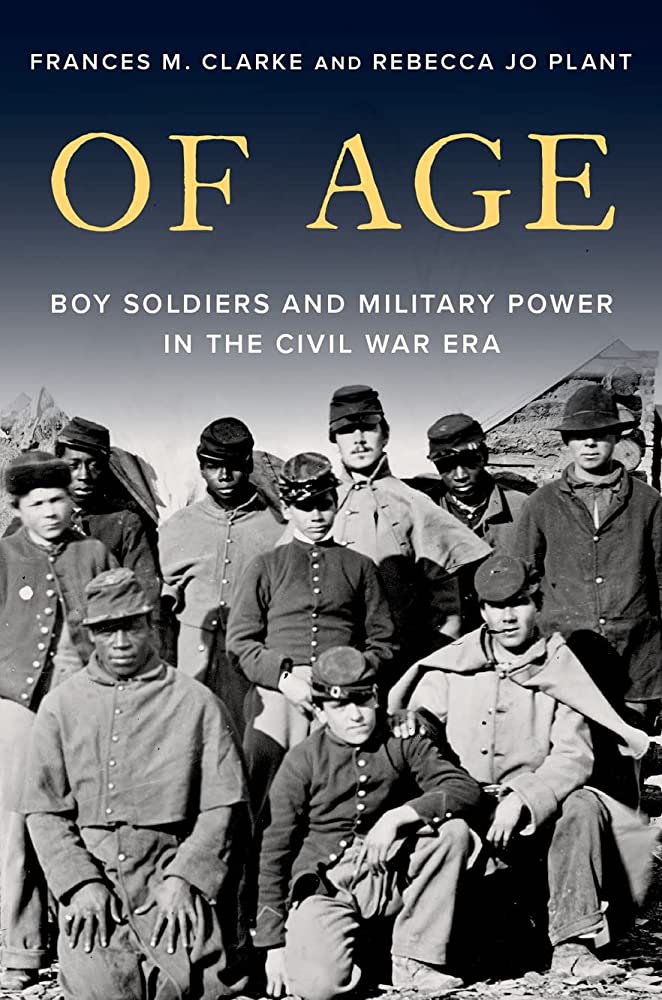Book Review: Of Age: Boy Soldiers and Military Power in the Civil War Era

 Of Age: Boy Soldiers and Military Power in the Civil War Era. By Frances M. Clarke and Rebecca Jo Plant. New York: Oxford University Press, 2023. 434 pp. Hardcover, $34.95
Of Age: Boy Soldiers and Military Power in the Civil War Era. By Frances M. Clarke and Rebecca Jo Plant. New York: Oxford University Press, 2023. 434 pp. Hardcover, $34.95
Reviewed by Tim Talbott
Youthful soldier Nicholas Ewing “Bud” Scott did not enlist until his eighteenth birthday. His older brother, Irby, preceded him in the Twelfth Georgia Infantry, by almost two years. Up until Bud’s enlistment, Irby advised his little brother to remain at home. In a letter, Irby outlined several reasons for the boy to not enlist. Irby believed Bud’s youthful “constitution” might be ruined by hard service and exposure to the elements. He also thought that the army was not the place for a boy to form habits. Irby thought there were enough men in the army at present (March 1862) without resorting to enlisting boys. In addition, their father needed Bud’s help more than the army did. Bud waited, probably impatiently, before he finally came “of age,” joining his brother, in the conflict that eventually resulted in his death.[1]
In Of Age: Boy Soldiers and Military Power in the Civil War Era, authors Frances M. Clarke and Rebecca Jo Plant explore the issues outlined by Irby Scott to his younger brother. They also examine a host of other social, political, economic, legal, and military questions that influenced citizens’ conceptions of what was a proper age for the belligerent governments to accept soldiers, and how the United States and Confederate States armies dealt with underage soldiers and their parents once within the ranks.
While historians have always understood that there were some boys in the Union and Confederate armies, they usually portrayed these youths as largely relegated to non-combat roles and being relatively few in number. For example, pioneering soldier-study scholar Bell Irvin Wiley believed that only about 1.6 percent of the Union army was underage. Clarke and Plant contend the number was at least ten percent. When one considers that the Federal army included about two million soldiers, ten percent is a substantial number.
However, the authors’ purpose in researching and writing this book is not so much in telling the story of youthful soldiers, but rather exploring what factors allowed so many boys to enlist and the consequences of their service. In turn, this work provides students of the conflict with important new viewpoints to think about in relation to the Civil War’s boy soldiers.
Providing helpful context to the situation of underage soldiers of the Civil War era, the authors open the book by examining perceptions of boys in the military during the early nineteenth century, particularly the War of 1812. In an age where most citizens feared a large national army, believed underage bodies unable to endure difficult soldier service, and enlistments were supposed to be limited to those twenty-one and over, those ideas began to change as the demand for soldiers increased during the Civil War.
Part II examines the catalysts changing public sentiment toward boys serving. The Civil War’s enormous impact on Americans helped to quickly reorient citizens’ positions on boy soldiers. Some viewed the experience of war as a positive for impressionable youth, akin to an apprenticeship to manhood. Although perhaps strange thinking to us today, some viewed learning to become part of a team, overcoming adversity, and seeing first-hand what was required to maintain (or establish) a republic as a beneficial experience for youths. Similarly, literature, songs, and printed art of the period emphasized the stimulating inspirational influence boys could have on the war effort.
The authors spend a considerable portion of their study looking at the conflict that arose between the Federal government and parents wishing to reclaim underage sons who enlisted without their consent. Their examination of these debates brought up interesting findings. They observed that it was more often the United States government who rejected such child reclamation appeals rather than the Confederacy. Unionist parents, believing that children and their labor were foremost under the power of their guardians, sought various means including habeas corpus petitions, to try get their boys discharged from the United States army, often unsuccessfully. Due to Lost Cause nostalgia, the perception that the Confederacy expended all of its resources, including its boys (“seed corn” in period terms) became an entrenched traditional view. However, as the authors point out, at the end, the Confederacy seemed more willing to enlist the enslaved than “force boys below military age into the field.” (225)
Organized advantageously into the three parts, each scaffolding from the preceding, helps readers better understand this previously understudied topic. The authors use a plethora of diverse sources to help provide evidence for their conclusions. Provost marshal and courts martial records, census data, newspaper articles, period fiction and school books, memoirs, letters and journals, and even sheet music are all incorporated. In addition, two intriguing appendices help explain the authors’ use of modern statistics and sampling in their conclusions.
Of Age makes a welcome contribution to an important but previously underexplored aspect of the Civil War, and suggests we reconsider traditional interpretations about its boy soldiers. The book’s depth of research and readability will certainly appeal to all students of the conflict.
[1] Johnnie Perry Pearson, Lee and Jackson’s Bloody Twelfth: The Letters of Irby Goodwin Scott, First Lieutenant, Company G, Putnam Light Infantry, Twelfth Georgia Volunteer Infantry (Knoxville: University of Tennessee Press, 2010), 64.
2 Responses to Book Review: Of Age: Boy Soldiers and Military Power in the Civil War Era